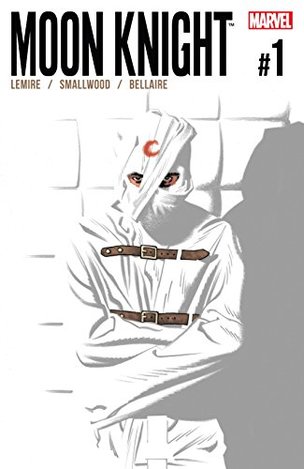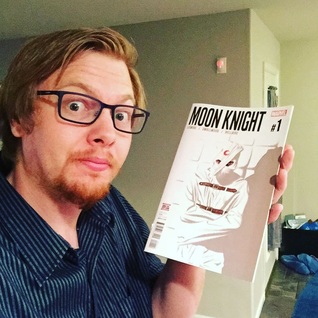Written by Joel T. Lewis The first issue of Moon Knight 2016 wastes no time in establishing tone, setting, and subject matter: and all of that comes before page 1. Old Moonie is right where we’ve speculated he'd end up someday: on the wrong side of a padded cell, with his white straight jacket, and a crescent moon cut into his forehead. In this run, Jeff Lemire places Moon Knight’s sanity under the microscope as Spector wakes from a vision of Khonshu to discover that he is an inmate at an asylum for the insane. Spector struggles to reason out which of the multiple personalities of his past is the real one only to discover that his therapist Dr. Emmet insists that none of Spector’s past was real. According to Dr. Emmet, Spector has been a resident of the asylum since he was 12 and has used the vigilante Moon Knight (who actually exists) as an escapist fantasy. Lemire, through Dr. Emmet, suggests that all we know of Moon Knight, but that Jake Lockley, Steven Grant, and Marc Spector could have been imaginary this whole time. The truth is unclear as Spector is torn between the “reality” of the asylum around him and the vivid flashbacks triggered during his search for answers. Spector is not alone as familiar faces Gina, Marlene, and Crawley are residents of the asylum too. Gina and Marlene seem to have no idea where they are or who they were, while Crawley, unsurprisingly, seems to be in his element, serving as Spector’s tour guide within the asylum walls. The thorazine drips and threats of shock treatment seem to have had no effect on Crawley’s chipper demeanor as he attempts to reassure Spector of his identity as the Fist of Khonshu: Moon Knight. Khonshu himself makes a brief appearance in the opening dream sequence compelling Spector to remember his “pasts” as Moon Knight and urges him towards the end of the issue to escape the bonds of the asylum’s mundane reality.  Greg Smallwood’s artwork mirrors Spector’s introspection as he flashes between the “remembered” past as Moon Knight and the apparent reality of the asylum. The colors and texture of the remembered panels strike out in harsh contrast to the bright, antiseptic asylum panels. The reader is, as Spector is, more convinced of the validity of the memories than the reality presented to them. This is complicated however, as the vibrancy of these panels would seem to be too vivid and too surreal to be credible. Smallwood’s panels defy margins and leave more blank space than content as their shape mirrors the content of the panels: as Spector is knocked unconscious the panels seem to trickle off into unconsciousness as he does. Also, at times the shape of Smallwood’s panels serve as punctuation: as Spector is subjected to electroshock treatment the dial controlling the current running through his body is the dot of an exclamation point. This narrowing of panels from page to page focuses your gaze and intensifies the action of those panels. This style of paneling also establishes expectations that are blown away by massive splash pages whose scope and scale hit home all the harder for coming after the decrescendo of the page before. This is not the first story arc to tackle the tricky subject of Marc Spector’s sanity (or lack thereof) as we have seen Moon Knight driven to psychotic rage and mutilation of his victims in the past. However, this is the first series of Moon Knight that I’ve read that attempts to capture the how cerebral madness can be and challenges both the reader’s and Spector’s faith in the legitimacy of Moon Knight’s legacy. Overall, I believe this issue succeeds in establishing the tone and style necessary to explore the Madness of Marc Spector (which would be a great title for a series of Moon Knight by the way) in an accessible and compelling way.
0 Comments
Leave a Reply. |
Archives
May 2024
|
|
© 2012-2025, Nerds That Geek LLC.
All Rights Reserved. |
uWeb Hosting by FatCow
